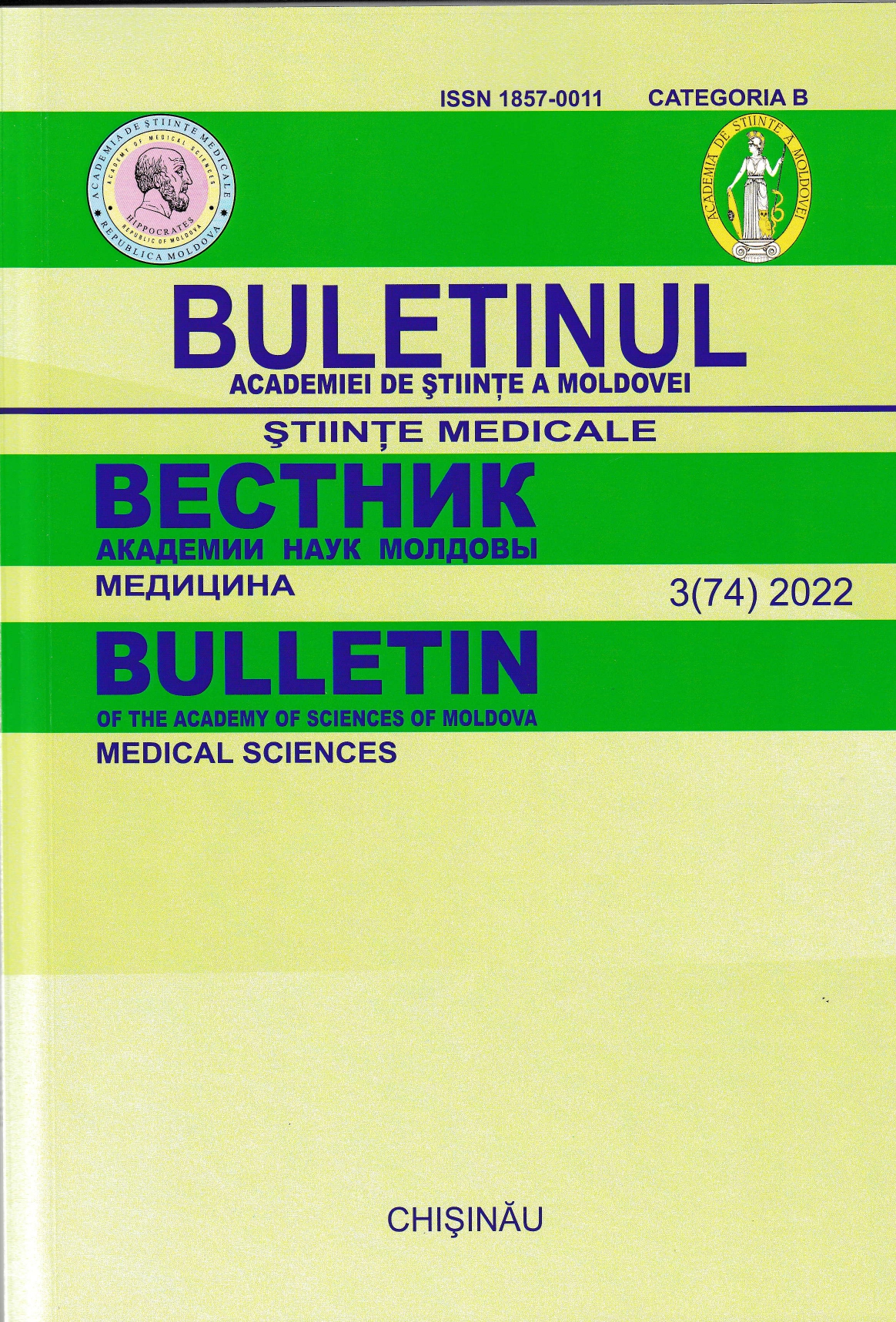Факторы риска и время ожидания в очереди на трансплантацию печени: из базы данных Республики Молдова
DOI:
https://doi.org/10.52692/1857-0011.2022.3-74.31Ключевые слова:
трансплантация печени, острая и хроническая печеночная недостаточностьАннотация
Трансплантация печени является важным методом лечения острой печеночной недостаточности и терминальной стадии заболевания печени. В 2002 году была включена модель терминальной стадии заболевания печени (MELD) для определения приоритетности пациентов, ожидающих трансплантации печени. Хотя есть данные о том, как оценка MELD влияет на время ожидания, литературы по другим компонентам не хватает. Мы стремились оценить факторы, влияющие на время ожидания TH. Используя базу данных из Республики Молдова, были включены пациенты в возрасте 18-65 лет, находящиеся в очереди на трансплантацию печени в период 2013-2022 гг. Переменные, протестированные в модели, включали характеристики пациента, биохимический анализ, оценку MELD и группу крови ABO. Оценка MELD используется для определения приоритетности распределения печени и, как ожидается, предсказывает время нахождения в листе ожидания. Искусственная вентиляция легких и другие маркеры тяжести заболевания связаны с более высокими баллами по шкале MELD и, таким образом, с более коротким временем ожидания. Необходимы дальнейшие исследования, чтобы выяснить причины различий во времени ожидания, чтобы попытаться сократить время до TH, стандартизировать процесс регистрации и улучшить результаты лечения пациентов.Цели. Целью научной работы был анализ факторов риска и времени ожидания пациентов с заболеваниями печени в листе ожидания на трансплантацию печени. Материалы и методы. Проведено ретроспективное 2013-2018 гг. и проспективное 2018-2022 гг. исследование, в которое были включены 265 пациентов с декомпенсированным циррозом печени, находящихся в листе ожидания на трансплантацию печени. В качестве источника научной литературы также использовались следующие базы данных: Google Scholar, PubMed и eLibrary. Ключевые слова, которые использовались при поиске:«пересадка печени», «острая и хроническая печеночная недостаточность».Результаты. Наши результаты показывают, что у пациентов с более низким содержанием натрия в сыворотке время ожидания было короче по сравнению с кандидатами с более высоким содержанием натрия. Таким образом, больше всего заболевших оказались пациенты с группой крови А, что также является прогнозом для данной группы более подверженной риску вирусной инфекции.
Библиографические ссылки
Alberino F, Gatta A, Amodio P, et al. Nutrition and survival in patients with liver cirrhosis. Nutrition. 2001;17:445–450.
Bernardi M, Gitto S, Biselli M. The MELD score in patients awaiting liver transplant: strengths and weaknesses. J Hepatol. 2011;54:1297–1306.
Borroni G, Maggi A, Sangiovanni A, Cazzaniga M, Salerno F. Clinical relevance of hyponatraemia for the hospital outcome of cirrhotic patients. Dig Liver Dis. 2000;32:605–610.
Brown RS, Jr, Lake JR. The survival impact of liver transplantation in the MELD era, and the future for organ allocation and distribution. Am J Transplant. 2005;5:203– 204.
Cholongitas E, Burroughs AK. The evolution in the prioritization for liver transplantation. Ann Gastroenterol. 2012;25:6–13.
Freeman RB, Wiesner RH, Edwards E, Harper A, Merion R, Wolfe R, United Network for Organ Sharing Organ Procurement and Transplantation Network Liver and Transplantation Committee Results of the first year of the new liver allocation plan. Liver Transpl. 004;10:7–15.
Gunsar F, Raimondo ML, Jones S, et al. Nutritional status and prognosis in cirrhotic patients. Aliment Pharmacol Ther. 2006;24:563–572.
John S, Thuluvath PJ. Hyponatremia in cirrhosis: pathophysiology and management. World J Gastroenterol. 2015;21:3197–3205.
Kamath PS, Wiesner RH, Malinchoc M, et al. A model to predict survival in patients with end-stage liver disease. Hepatology. 2001;33:464–470.
Kim WR, Biggins SW, Kremers WK, et al. Hyponatremia and mortality among patients on the liver-transplant waiting list. N Engl J Med. 2008;359:1018–1026.
Malinchoc M, Kamath PS, Gordon FD, Peine CJ, Rank J, ter Borg PC. A model to predict poor survival in patients undergoing transjugular intrahepatic portosystemic shunts. Hepatology. 2000;31:864–871.
Merion RM, Schaubel DE, Dykstra DM, Freeman RB, Port FK, Wolfe RA. The survival benefit of liver transplantation. Am J Transplant. 2005;5:307–313.
Merli M, Riggio O, Dally L. Does malnutrition affect survival in cirrhosis?PINC (Policentrica Italiana Nutrizione Cirrosi) Hepatology. 1996;23:1041–1046.
Myers RP, Tandon P, Ney M, et al. Validation of the five-variable Model for End-stage Liver Disease (5vMELD) for prediction of mortality on the liver transplant waiting list. Liver Int. 2014;34:1176–1183.
Porcel A, Díaz F, Rendón P, Macías M, Martín-Herrera L, Girón-González JA. Dilutional hyponatremia in patients with cirrhosis and ascites. Arch Intern Med. 2002;162:323–328.
Ruf AE, Kremers WK, Chavez LL, Descalzi VI, Podesta LG, Villamil FG. Addition of serum sodium into the MELD score predicts waiting list mortality better than MELD alone. Liver Transpl. 2005;11:336–343.
Transplant trends. [[Accessed 6 November 2017]].
Загрузки
Опубликован
Лицензия
Copyright (c) 2022 Вестник Академии Наук Молдовы. Медицина

Это произведение доступно по лицензии Creative Commons «Attribution» («Атрибуция») 4.0 Всемирная.



